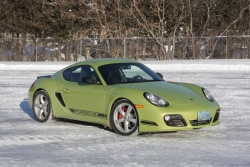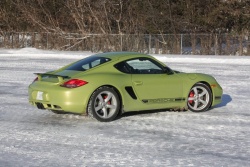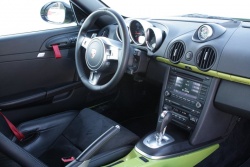2007 Porsche Cayman. Click image to enlarge |
By Jeff Burry; photos by Chris Chase
Photo Gallery:
Porsche Cayman
The Porsche Cayman, first introduced for the 2006 model year, was derived from Porsche’s second-generation Boxster, dubbed the 987. A mid-engine, rear-wheel drive two-seat sports car with a fixed roof, the Cayman was referred to by insiders as the 987c.
Sharing about 40 per cent of its components with the Boxster, the Cayman was introduced to the marketplace with the intention of closing the gap, ever so slightly, between the Boxster and its big brother, the Porsche 911.
Engineers were careful, even respectful, to not offer horsepower ratings that would encroach upon 911 territory. However, being a “fixed top” car, the Cayman would offer a slightly more exhilarating ride, assisted in part by a rear strut tower brace that exceeds the Boxster’s by 150 per cent.
2007 Porsche Cayman. Click image to enlarge |
Weight distribution was 55 per cent rear and 45 per cent front, depending on options. The 2006 Cayman came standard with 18-inch wheels (19s were optional). Its centre of gravity was approximately 15 mm higher than that of the Boxster, but its rakish rear hatch provided a lower drag coefficient.
In its inaugural year, the only engine choice was a 3.4-litre flat-six engine which made 295 horsepower. This could have been mated to either a six-speed manual transmission or a five-speed Tiptronic with paddle shifters (available as an option).
Based on the 3.2-litre flat-six found in the Boxster S, the 3.4-litre Cayman S engine used the same VarioCam Plus camshaft and valve lift technology as was found in the Porsche 911 Carrera.
For the 2007 model year, Porsche offered a 2.7-litre version of the company’s iconic flat-six engine used in the base Boxster. It produced 245 horsepower at 6,500 rpm and 201 lb.-ft. of torque at 5,000 rpm. Caymans equipped with the 2.7-litre powerplant retailed for approximately $10,000 less than the Cayman S.
So what could the extra ten bills buy you? For starters, a larger powerplant shaving nearly seven seconds off the zero-to-100 km/h time (estimated at 5.1 seconds), larger wheels, bigger brakes and a six-speed manual gearbox, versus a five-speed, found in the 2.7-litre version of the Cayman.
2007 Porsche Cayman. Click image to enlarge |
Standard features found on the 2007 version included anti-lock brakes, stability and traction control, torso and head-protecting and side-impact airbags.
For 2008, the Cayman received only minor enhancements found mostly on the options list. New carbon-fibre leather-wrapped seats were available, cutting eight kilograms off the weight, and there was also a new styling package available for the Cayman referred to as the Porsche Design One (PDO). That included enhanced design features such as chrome-plated tailpipes, new custom interior colour scheme, 19-inch wheels and black paint with matte black stripes.
From 2006 through to 2008 there were only modest changes made to the highly successful Cayman. For the 2009 model year, Porsche decided to upgrade both available powertrains as well as tweak some exterior and interior design cues.
The base model’s displacement rose from 2.7 litres to 2.9 litres (providing for an extra 20 horses bringing it to 265) and the Cayman S got direct fuel injection, boosting its horsepower rating to 320.
Perhaps the most significant upgrade was the introduction of the Porsche Doppelkupplungsgetriebe, otherwise known as PDK, or dual-clutch transmission.
The PDK transmission is a seven-speed automated system that enables the driver to switch between automatic and manual shifting, compliments of paddle shifters mounted on the steering wheel. Both modes provided for an invigorating driving experience, with the PDK transmission also providing quicker acceleration and enhanced fuel economy.
The centre stack also received a modest upgrade for 2009 to incorporate Porsche’s new touch-screen interface. As in previous years, the options list continued to grow (over 140 available options and growing) enabling individuals to truly personalize their Cayman.
Options were varied, with some of the more popular ones being 19-inch wheels, ceramic composite brakes, rear window wiper, ventilated seats and a heated steering wheel for those in northern climes. Delving into that list could easily inflate the final price of a Cayman close to the six-figure threshold.
   2007 Porsche Cayman. Click image to enlarge |
Little changed for the 2010 model year, save for some exterior colour choices (Dark Blue was added while Midnight Blue was dropped), due to the numerous enhancements incorporated into the 2009 Cayman.
The same could be said for the 2011 version, which now included as standard Bluetooth connectivity, iPod interface and floor mats. Inching ever closer to the 911 in terms of styling and performance, Porsche purposefully settled for only modest tweaks in each of those two model years.
So what may be in store for 2012? Enter the Porsche Cayman R, weighing in at a svelte 55 kg less than the “S,” compliments of aluminum hood and door skins, lighter wheels, carbon fibre seat shells, Aerokit front and rear spoilers, and, oh yes, those red fabric door straps, also found in the Porsche 911 Carrera GTS, suggesting this latest rendition of the Cayman is all business.
The “R” badge on the Cayman pays homage to the very first Porsche with the “R” designation, the 1967 Porsche 911 R. This latest variant of the Cayman is not only lighter, but the 3.4-litre flat-six has been tweaked to pump out 330 horsepower (10 more than the Cayman S) at 7,400 rpm. With a total weight of only 1,295 kg, its power-to-weight ratio is an impressive 3.8 kg per horsepower.
The Cayman R comes standard with a six-speed manual transmission, or can be equipped with the PDK transmission, which will set you back a lofty $4,180. It is worth every cent, especially if you plan on using this vehicle for your daily commutes.
The base Cayman R comes standard without either air conditioning or a stereo system (thus contributing to the significant weight reduction over the Cayman S), but these can be added for a combined $2,800 over the $75,600 MSRP.
Clearly, with the introduction of the Cayman R, the gap between it and the Porsche 911 is shrinking both in terms of performance and price point.
Regardless of model year, the Cayman is a “driver’s car.” It is perhaps the consummate vehicle in which driver is truly connected to machine.
As Lou Reed might have suggested back in 1972, “take a walk on the wild side.”
For further information on the Cayman R or any other Cayman models (including the Cayman S Black Edition), check out the Autos.ca Buyer’s Guide.











